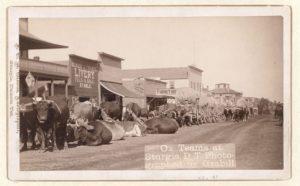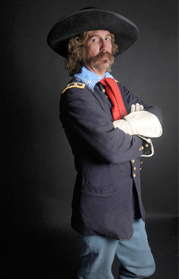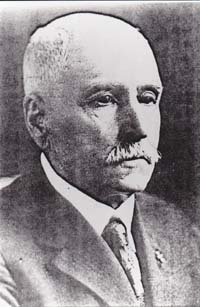Alexander Brown was born on February 19, 1844, in Aberdeen, Scotland. He was a Sergeant in Company G and was with the pack train and in the hilltop fight. He died of syphilis in 1884 in Sturgis, South Dakota. Other Seventh Cavalry members who died in Sturgis included Joseph Bates (1893), Edward Garlick (1931), John E. Hammon (1909), Max Hoehn (1911), and John J. Mahoney (1918). The photo (left) of ox teams in Sturgis was taken by John C. H. Grabill, probably between 1887 and 1892.
Other Seventh Cavalry milestones this week include:
Thomas Hughes, who was also known as Charlie Hughes, was born in County Mayo, Ireland, on February 21, 1845. He was a Private in Company H who was wounded in the hilltop fight. He died in Nashville, Tennessee, on August 12, 1911, and was buried in the National Cemetery there.
Charles Ackerman married Ephresina Peterson on February 21, 1881, at Fort Totten. He was not present during the battle due to detached service at the Power River Depot.
Michael Vincent Sheridan died on February 21, 1918, in Washington, D.C., and was buried in Arlington National Cemetery. He was the brother of General Philip Henry Sheridan.
Dennis Lynch was born on February 22, 1848, in Cumberland, Maryland. He was a Private in Company F who was not at the battle due to detached service. He died in 1933 in Washington, D.C.
Andrew Humes Nave was born in Knoxville, Tennessee, on February 23, 1846. He was a Second Lieutenant in Company I, but he was not present at the battle due to illness.
Jan Moller, also known as James Moller, died on February 23, 1928, in Deadwood, South Dakota, and was buried in the Mount Moriah Cemetery there. He was wounded in the hilltop fight.
George A. Rudolph was born in Meuterheim, Germany, on February 24, 1854. He was a Private in the Band. He was not present at the battle due to detached service at Powder River, Montana.
Charles Louis Haack died on February 24, 1902, at the U.S. Soldiers Home in Washington, D.C., and was buried in its National Cemetery. He was not present at the battle due to illness.
Joseph Greene Tilford died in Washington, D.C., on February 24, 1911, and was buried in Arlington National Cemetery. He was a Major who was not present at the battle due to detached service.
John Hackett died on February 25, 1904, at Fort Sheridan, Illinois, of heart disease and was buried in the cemetery there. He was in the valley and hilltop fights and was wounded in his left arm.





